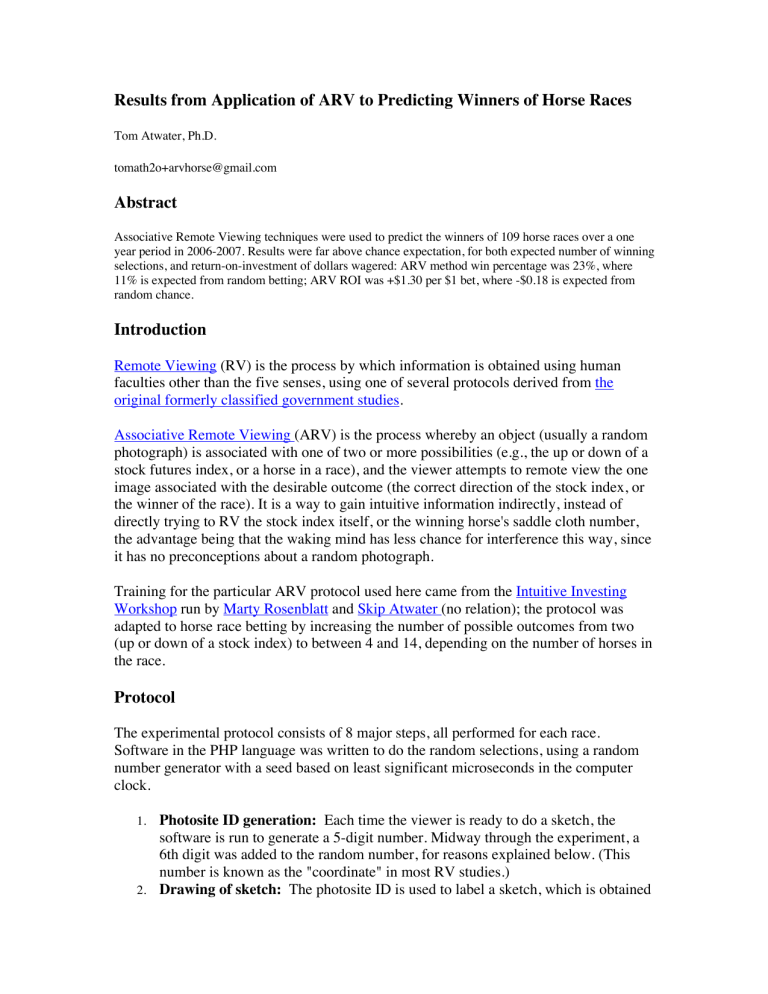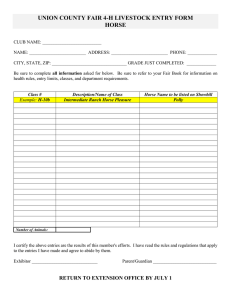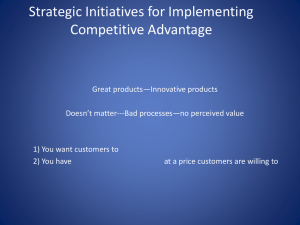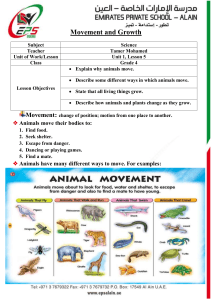
Results from Application of ARV to Predicting Winners of Horse Races Tom Atwater, Ph.D. tomath2o+arvhorse@gmail.com Abstract Associative Remote Viewing techniques were used to predict the winners of 109 horse races over a one year period in 2006-2007. Results were far above chance expectation, for both expected number of winning selections, and return-on-investment of dollars wagered: ARV method win percentage was 23%, where 11% is expected from random betting; ARV ROI was +$1.30 per $1 bet, where -$0.18 is expected from random chance. Introduction Remote Viewing (RV) is the process by which information is obtained using human faculties other than the five senses, using one of several protocols derived from the original formerly classified government studies. Associative Remote Viewing (ARV) is the process whereby an object (usually a random photograph) is associated with one of two or more possibilities (e.g., the up or down of a stock futures index, or a horse in a race), and the viewer attempts to remote view the one image associated with the desirable outcome (the correct direction of the stock index, or the winner of the race). It is a way to gain intuitive information indirectly, instead of directly trying to RV the stock index itself, or the winning horse's saddle cloth number, the advantage being that the waking mind has less chance for interference this way, since it has no preconceptions about a random photograph. Training for the particular ARV protocol used here came from the Intuitive Investing Workshop run by Marty Rosenblatt and Skip Atwater (no relation); the protocol was adapted to horse race betting by increasing the number of possible outcomes from two (up or down of a stock index) to between 4 and 14, depending on the number of horses in the race. Protocol The experimental protocol consists of 8 major steps, all performed for each race. Software in the PHP language was written to do the random selections, using a random number generator with a seed based on least significant microseconds in the computer clock. Photosite ID generation: Each time the viewer is ready to do a sketch, the software is run to generate a 5-digit number. Midway through the experiment, a 6th digit was added to the random number, for reasons explained below. (This number is known as the "coordinate" in most RV studies.) 2. Drawing of sketch: The photosite ID is used to label a sketch, which is obtained 1. 3. 4. 5. 6. 7. 8. after the viewer sets his intent to view that particular image which is sent in email to the viewer in the future, showing the photosite associated with the winning horse. Drawing of sketches involves an initial "cool-down" period of relaxation, and usually occurred throughout the week preceding the weekend's races. Drawing of the sketch always preceded the following steps. Race selection: For most of the experiment, races were selected at random from a list of graded stakes races at major North American Thoroughbred tracks for a given weekend; these are the highest class races with the fastest horses, and usually produce the most reliable results. The number of races selected to process was equal to the number of sketches available at the beginning of the weekend. Each race was associated with a photosite ID randomly. Image selection:The 5-digit number generated in step 1 was used as the search string in a Google Images advanced search with parameters medium size, JPG filetype, and SafeSearch strict filtering on. Midway through the experiment, a 6th digit was added to the random number, for specifying the page number of the images returned (Google returns about 20 images per page), this in order to avoid image duplication should the same 5-digit number come up twice. The pictures are then filtered manually, with non-photographic images (e.g., computer graphics), images from a website already used once for this photosite ID, and images obviously of the same object (e.g., photos of the same object in two different online catalogs) rejected as possible photosites. The number of images collected per race was one for each horse in the race, each labeled with a letter. Association of images with horses: The software randomly assigns an image identifier letter to a horse name, for each horse in the race, saving the result in a computer file. The viewer does not read this file until after the judging. Judging: The viewer self-judges the 4 to 14 images for the race, comparing each to the sketch from step 2. The viewer assigns a Targ Confidence Ranking rating from 0-7 for quality of the match. (This step was performed both before and after step 5, in the spirit of the timelessness of psychic phenomena. ) Race result: The race is run, and the results recorded along with all of the above data on an internal web page, and on the summary spreadsheet. The horse with the highest Targ Confidence Ranking is the ARV selection. Email of photosite: The viewer notes the image associated with the winning horse, and sends that image via email to himself. This step is part of the protocol to reinforce the successes for the intuitive/RV self. In parallel to the ARV protocol, the viewer used standard horse race handicapping techniques to make a logical selection of the horse most likely to win the race, using past performance data purchased from Bloodstock Research Information Services, together with 35 years experience in horse race handicapping. This was almost always performed before step 6, judging. The viewer also used both ARV and logical selections to make bets of various amounts. For each race, the ARV protocol takes about one hour to accomplish. Logical horse selection takes an addition 1/2 to 1 hour. It has been noted previously that the intent of the experimenter is a factor in experiments such as these that involve intuitive information, so some of the viewer's beliefs on this subject are given here. The viewer in these experiments believes strongly in the reality of extra-sensory methods of accessing information, and considers himself to have an open mind about most if not all subjects. He also strongly believes in his own intuitive self. Results The ARV method was used in 109 races from March 2006 to March 2007, and selected 25 winners, or 23%. Since the average number of horses in a race was 8.7, selecting the winner at random would imply a win percentage of 1/8.7, or 11%. That is, the ARV win percentage is more than double the expected rate. In making bets, the ARV method's winners averaged 9.0 to 1 odds, resulting in a returnon-investment (ROI) of +$1.30 for $1 (more than double the bet). For example, bets of $100 on each race would have returned $25,070, or $14,170 net profit, for the total bets of $10,900 over the year. Horse race betting is a pari-mutuel game, meaning the track takes a percentage off the top before calculating the odds for payoffs to winning bettors. For win bets this is an average of 18%; therefore, the expected ROI for random win betting is about -$.18 lost per dollar bet. (Average odds for a winning horse are about 3.5 to 1.) So the ARV method's 130% profit is far above the expected 18% loss for random bets. The results for the viewer's logical handicapping picks were as follows: in 111 races, the viewer selected 42 winners, or 38%; the average winning odds was 3.3 to 1, for an ROI of +$.29 per $1 bet (profit of 29%). These results are about as good as any that are reported in the horse race handicapping literature. (Note that while these races occurred over the same time period as the ARV races, they were not always the same races as the ARV method predicted, for various reasons.) So although the logical win percentage was 30% higher than the ARV win percentage, the ARV ROI was more than triple the logical ROI, meaning one would make three times as much money betting the ARV selections. This is the result of the larger number of longshots (high odds horses) selected by the ARV method; the logical method naturally selects lower priced horses, since the public at large uses many of the same logical processes and published past performance information. It must be noted that two of the ARV winners were extreme longshots, with odds of 48-1 and 91-1. Without these two winners, the average winning ARV odds drops to 3.7 to 1, and the ROI drops to a net loss of 15%, close to the expected random result. One interesting bit of information: in the 14 races where the ARV choice and the viewer's logical handicapping choice was the same horse, that horse won an amazing 9 times (64%), with an ROI of +$1.78, or nearly triple the initial stake (and this did not include the two extreme longshots). The place (i.e., horse finishes first or second) success rate was even more incredible - the "same" horse placed in 13 of the 14 races. Conclusion An Associative Remote Viewing protocol was used to predict the outcome of 109 horse races, with a success rate of 23%, well above the expected random rate of 11%. The ROI for the ARV method was +$1.30 for $1, also well above the expected random result of -$0.18. Due to the large impact of two longshots on the ARV ROI, it could be argued that the positive ROI results stated here are fluctuations; however, the longshots have no effect on the anomalous ARV win percentage of 23%. Although one cannot plausibly draw definitive conclusions based on 14 events, the very large win percentage and ROI for the races where the ARV and logical methods pick the same horse are a strong indication that logic and intuitive methods working together are the best methods of all. Overall, the number of trials in this experiment are not enough to draw definitive conclusions about ARV or about intuitive methods in general - and that is one of the reasons why no effort was made to use standard statistical methods. However, these results do lend credence to the view that there are means to access information outside of the five senses. Further experimentation is needed for those that require proof of the validity of ARV methods for predicting horse race results.



